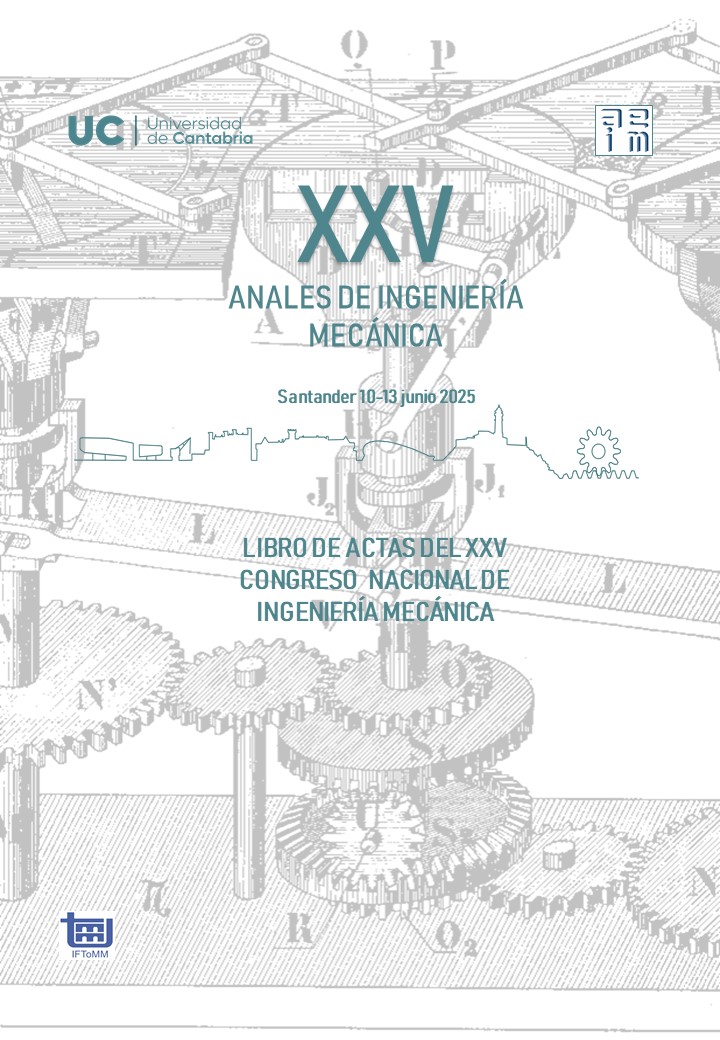Project activity in Central Italy: research projects at the University of Perugia and Siena
Contenido principal del artículo
Resumen
This paper highlights the activities of the Laboratory of Mechanics of Machines at both the University of Perugia and the University of Siena, where certain research projects are carried out collaboratively.
The research conducted at the University of Perugia, under the leadership of Prof. Maria Cristina Valigi and in collaboration with Prof. Silvia Logozzo, primarily focuses on robotic manipulators, tribological issues, and control of mechanical systems, The focus of the robotics research is on the development of underactuated monolithic grippers for industrial applications, designed to perform both compliant and powerful grasps. The ongoing development of these grippers remains a central aspect of the research, involving the design and prototyping of new models through experimental, numerical, and theoretical approaches. Recently, some rigid gripper prototypes have been studied for potential applications in the aerospace industry. In addition, leveraging extensive experience in tribological models and analysis, the research addresses specific tribological challenges in robotic fingers, particularly those related to precision grasping. This includes evaluating the contact issues of sensorized fingertips and proposing an innovative method for assessing contact imprints using 3D scanning technologies. The research at the University of Perugia also focuses on tribological issues related to contact analysis, wear, and lubrication of industrial and biomechanical components. Among these, it is worth mentioning the experimental 3D wear analysis of knee and hip prostheses, including retrieved implants, as well as the modeling of friction instabilities in mechanical face seals.
The University of Siena research group coordinated by Prof. Malvezzi focuses on robotics, haptics, and mechanical systems. The research is highly interdisciplinary, blending mechanical design, control systems, and advanced robotics, as well as aspects related to human factors and user studies. The main contributions lie in the development of innovative robotic hands, soft robotic systems, and human-robot interaction technologies. A significant aspect University of Siena research group involves the design of underactuated robotic hands and grippers. These systems incorporate compliant mechanisms and modular designs, which improve adaptability and reduce control complexity. The Siena research group also explored haptic feedback systems, particularly in wearable robotics. Recent projects include the design of robotic gloves for enhancing tactile sensations and facilitating interactions in virtual environments. The research into haptic devices integrates human-centered approaches, examining how tactile feedback can improve the realism and functionality of robotic systems. Siena research group contribution is also on theoretical advancements in robotics, including the study of hand synergies, a concept inspired by the coordination of human hand movements investigating how a reduced set of control inputs can effectively manage complex robotic systems, an approach that enhances the efficiency and usability of robotic hands in tasks like grasping and manipulation. Recent studies improve robot sensing and actuation through twisted string actuators and soft pneumatic pads, with applications in healthcare and industry.
University and Siena and University of Perugia research groups coordinated by Prof. Valigi and Prof. Malvezzi have collaborated extensively in underactuated mechanisms and soft robotics exploring the design and control of modular, compliant robotic grippers and hands, with an emphasis on tendon-driven, underactuated wearable robotic fingers. They work on integrating soft and rigid elements to improve performance in dynamic environments, with applications in healthcare, industrial automation, and human-robot interaction. Additionally, they develop software tools for modeling and prototyping robotic devices and have applied their research to wearable robotics for rehabilitation, including physiotherapy protocols.
Detalles del artículo

Esta obra está bajo una licencia internacional Creative Commons Atribución-NoComercial-CompartirIgual 4.0.
CC BY-NC-SA 4.0)
El lector puede compartir, copiar y redistribuir el material en cualquier medio o formato, siempre y cuando cumpla con las siguientes condiciones:
-
Atribución (BY): Debe dar crédito adecuado al autor original, proporcionando un enlace a la licencia y señalando si se han realizado cambios.
-
No Comercial (NC): No puede utilizar el material con fines comerciales. Esto significa que no puede venderlo ni obtener ganancias directas de su uso.
-
Compartir Igual (SA): Si adapta, transforma o construye sobre el material, debe distribuir sus contribuciones bajo la misma licencia que el original.
Recuerda que esta licencia no afecta los derechos legales del autor, como el derecho moral o las excepciones de uso justo.

